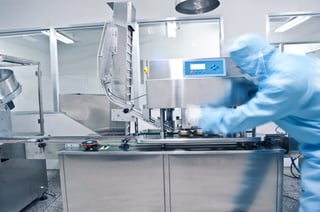 In the pharmaceutical industry, the risk of microbial infection is a serious threat. This is why many companies in this industry frequently use antimicrobial coatings on their custom containers, from stainless steel baskets to parts holding trays.
In the pharmaceutical industry, the risk of microbial infection is a serious threat. This is why many companies in this industry frequently use antimicrobial coatings on their custom containers, from stainless steel baskets to parts holding trays.
There are many different kinds of antimicrobial coatings that rely on a number of different properties to prevent the attachment/growth of bacteria to their surfaces.
For example, some antimicrobial coatings rely on unique surface properties to keep bacteria from sticking to them and surviving, while others use chemical reactions to sterilize bacteria. The silver-based antimicrobial coating used by Marlin Steel falls into the latter category.
To give you an idea of how Marlin Steel’s antimicrobial coating for stainless steel baskets works, here are a few answers to some frequently asked questions that clients in the pharmaceutical industry have about the coating:
What Microbes Does Marlin’s Coating Resist?
Marlin’s antimicrobial coating, as a silver ion-based coating, attaches to the DNA of certain microbes and causes damage, preventing the microbe from replicating and spreading. While some microbes may be able to resist this, the process has proven effective on dozens of bacteria strains, including:
- Bacillus cereus
- Mycobacterium tuberculosis
- Escherichia coli
- Klebsiella Pneumoniae
- Salmonella typhimurium
- Staphylococcus aureus
- Streptococcus faecalis
- Proteus mirabilis
- Vibrio parahaemolyticus
Just to name a few.
However, exposure to some chemicals may inhibit the function of the silver-based antimicrobial coating. According to research from the Welsh School of Pharmacy, University of Wales Cardiff in the UK, “test thiol-containing compound (sodium thioglycollate) neutralized the antibacterial action of silver nitrate agains Ps, aeruginosa PAOI and Staph. Aureus.”
The thiol-based compound kept the silver nitrate in the coating being researched from bonding with and killing the bacteria in the experiment the research paper was based on.
How is the Coating Applied?
The antimicrobial coating can be applied to stainless steel baskets or trays like any thermoset, electrostatic grade powder coating would.
Is the Coating an Aromatic Urethane?
Aromatic coatings have a ring structure which would be tighter, and thus longer-lasting, than many other chemical structures. This is why some of Marlin’s more chemical engineering-minded customers ask if the coating is an aromatic urethane.
Currently, the antimicrobial coating used by Marlin is available in TGIC-polyester, urethane-polyester, hybrid, and niloxy variations, but not in an aromatic urethane. While an aromatic coating might be developed later, there is not one available at this time.
Is the Coating Passive?
Passive coatings, like some popular cookware non-stick coatings, have the property of going onto a surface and staying on until they are damaged or scraped off.
The antimicrobial coating used by Marlin is an active coating, meaning that it is consumed over time as it performs its function. The silver ions that bond to and sterilize microbes are lost once used.
Because of this it is necessary to reapply the coating from time to time to maintain the microbe resistance of the basket being coated. Exactly how long the coating lasts depends on the use conditions of the basket, such as the amount of moisture and contaminants the basket is exposed to.
Are There Color Restrictions on the Coating?
So far, there have not been any restrictions on color that Marlin’s engineers have noticed when applying a color to the antimicrobial powder coat. However, like with other powder coatings, the cost of the coating is affected by the colors used in it.
Does an Antimicrobial Coating Cost More Than Other Powder Coatings?
On average, an antimicrobial powder coating will cost about twice as much as other powder coats. This is largely because of the cost of the active ingredient (silver) and the specialized method of incorporating it.
Does an Antimicrobial Coating Feel Different from Other Powder Coatings?
Generally speaking, the look and feel of an antimicrobial powder coating is indistinguishable from that of a normal powder coating. However, the incorporation process may lead to more orange peel than what would happen with a standard powder coat.
Overall, silver ion-based antimicrobial coatings can be an invaluable aid in helping to prevent the spread of bacteria in the pharmaceutical manufacturing process, one that more than offsets the cost of the coating.
Interested in learning more? Click here to download our Antimicrobial Guide!



.gif)


